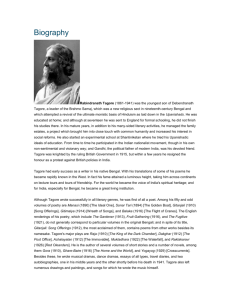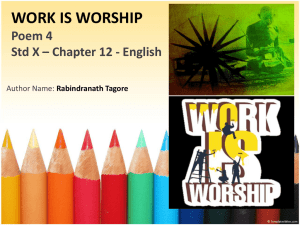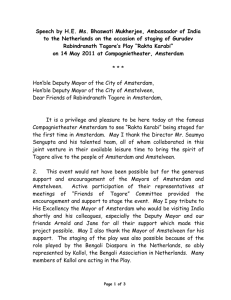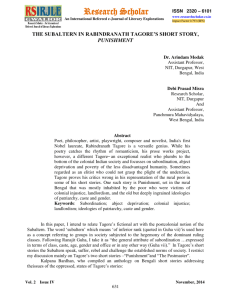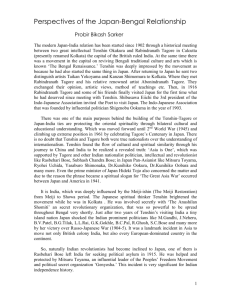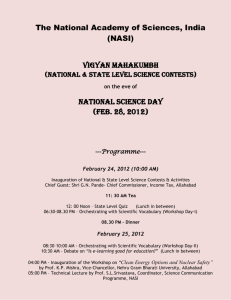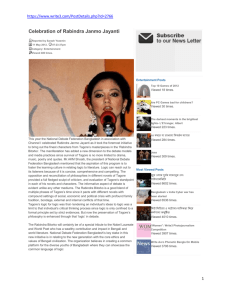Yugoslavia
advertisement
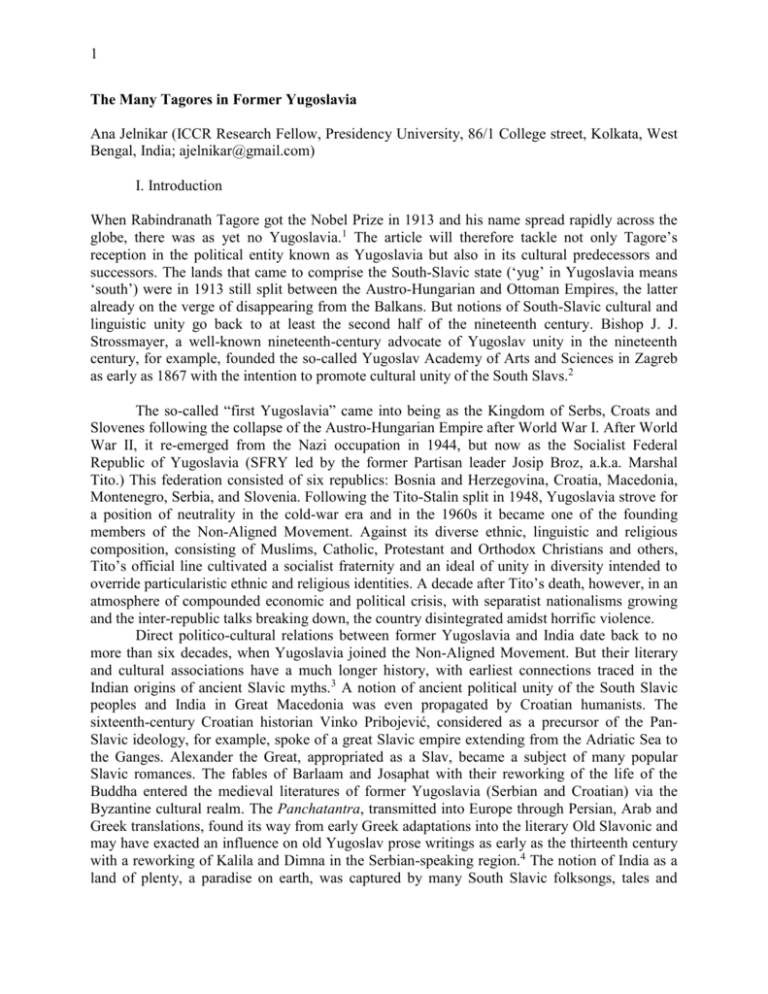
1 The Many Tagores in Former Yugoslavia Ana Jelnikar (ICCR Research Fellow, Presidency University, 86/1 College street, Kolkata, West Bengal, India; ajelnikar@gmail.com) I. Introduction When Rabindranath Tagore got the Nobel Prize in 1913 and his name spread rapidly across the globe, there was as yet no Yugoslavia.1 The article will therefore tackle not only Tagore’s reception in the political entity known as Yugoslavia but also in its cultural predecessors and successors. The lands that came to comprise the South-Slavic state (‘yug’ in Yugoslavia means ‘south’) were in 1913 still split between the Austro-Hungarian and Ottoman Empires, the latter already on the verge of disappearing from the Balkans. But notions of South-Slavic cultural and linguistic unity go back to at least the second half of the nineteenth century. Bishop J. J. Strossmayer, a well-known nineteenth-century advocate of Yugoslav unity in the nineteenth century, for example, founded the so-called Yugoslav Academy of Arts and Sciences in Zagreb as early as 1867 with the intention to promote cultural unity of the South Slavs.2 The so-called “first Yugoslavia” came into being as the Kingdom of Serbs, Croats and Slovenes following the collapse of the Austro-Hungarian Empire after World War I. After World War II, it re-emerged from the Nazi occupation in 1944, but now as the Socialist Federal Republic of Yugoslavia (SFRY led by the former Partisan leader Josip Broz, a.k.a. Marshal Tito.) This federation consisted of six republics: Bosnia and Herzegovina, Croatia, Macedonia, Montenegro, Serbia, and Slovenia. Following the Tito-Stalin split in 1948, Yugoslavia strove for a position of neutrality in the cold-war era and in the 1960s it became one of the founding members of the Non-Aligned Movement. Against its diverse ethnic, linguistic and religious composition, consisting of Muslims, Catholic, Protestant and Orthodox Christians and others, Tito’s official line cultivated a socialist fraternity and an ideal of unity in diversity intended to override particularistic ethnic and religious identities. A decade after Tito’s death, however, in an atmosphere of compounded economic and political crisis, with separatist nationalisms growing and the inter-republic talks breaking down, the country disintegrated amidst horrific violence. Direct politico-cultural relations between former Yugoslavia and India date back to no more than six decades, when Yugoslavia joined the Non-Aligned Movement. But their literary and cultural associations have a much longer history, with earliest connections traced in the Indian origins of ancient Slavic myths.3 A notion of ancient political unity of the South Slavic peoples and India in Great Macedonia was even propagated by Croatian humanists. The sixteenth-century Croatian historian Vinko Pribojević, considered as a precursor of the PanSlavic ideology, for example, spoke of a great Slavic empire extending from the Adriatic Sea to the Ganges. Alexander the Great, appropriated as a Slav, became a subject of many popular Slavic romances. The fables of Barlaam and Josaphat with their reworking of the life of the Buddha entered the medieval literatures of former Yugoslavia (Serbian and Croatian) via the Byzantine cultural realm. The Panchatantra, transmitted into Europe through Persian, Arab and Greek translations, found its way from early Greek adaptations into the literary Old Slavonic and may have exacted an influence on old Yugoslav prose writings as early as the thirteenth century with a reworking of Kalila and Dimna in the Serbian-speaking region.4 The notion of India as a land of plenty, a paradise on earth, was captured by many South Slavic folksongs, tales and 2 sayings throughout the Middle Ages and subsequent centuries and has survived to the present day in the popular phrase ‘India Koromandia’ (‘Koromandia’ refers to the Coromandel Coast where St. Thomas preached Christianity.)5 As Sanskrit, alongside classical Greek and Latin, came to be an essential component of philological education in Europe in the nineteenth century, Indian literature in this part Europe too became associated with ancient Indian texts. The first direct translations from Sanskrit were undertaken by Croatian Petar Budmani (1835-1914) and the Slovene Karol Glaser (1845-1913), who each translated a selection of Sanskrit tales and dramas, including Kalidasa’s Sakuntala, into Serbo-Croatian and Slovenian respectively. The acquaintance with Indian philosophy, Vedanta and Buddhist thought first came through German scholarship, and first reached those parts of former Yugoslavia that were under the Austro-Hungarian Empire. India was seen as a land of profound wisdom, albeit still tinged with exoticism. The Ottoman Empire, on the other hand, left a legacy of another version of ‘the Orient’. In 1955 Svetozar Petrović was still able to write that Yugoslav Orientalist studies were limited almost entirely to the study of Arabic, Persian and Turkish languages and literatures.6 Indology as a scholarly discipline came late in the day, the first academic institute established in the 1960s at the University of Zagreb. To this day Zagreb is the only capital in former Yugoslavia to systematically offer courses on Indian languages and cultures.7 As the first modern Indian author to be read in this part of the world, Tagore in former Yugoslavia soon became one of the most widely translated foreign authors of the time. His reputation went through different phases and his works met with various responses in different parts of former Yugoslavia. Overall, his fame seems to rest secured, as old and new translations are being published and reprinted to this day, and his poetry and novels are being taught at secondary school and university level, increasingly associated with world and post-colonial literatures. II. First Encounters The initial response to Tagore’s unexpected Nobel Prize in former Yugoslavia was shaped largely by considerations other than the poet’s literary merit. As elsewhere across Europe, the deeply meditative poems of Gitanjali were readily imbibed as the book of the soul and its author seen as a prophet and mystic from the East. The full translation of the Nobelwinning collection of poetry first came out serially in 1914 in a Zagreb daily (Jutranji list) and published in book form a year later.8 Christian intellectuals of the day were keen to assimilate Tagore’s perceived mysticism into their own strivings to reject the world of materialism and secularism.9 Yeats’s famous “Introduction” to the English Gitanjali, which launched some of the more persistent misconceptions about the Indian poet, found its way into the earliest writings on Tagore also in former Yugoslavia. For example, in Slovenia, one of the first articles to be written on Tagore was almost entirely based on Yeats’s laudatory preface.10 For the Slavic peoples who were most exposed to the Germanization pressures under the Habsburg rule, Tagore’s winning the Nobel Prize became a matter of preference over another candidate for the biggest literary accolade that year, the Austrian poet Peter Rosegger (18431918). Certainly the Slovenes resented Rosegger for his associations with the nationalist organisation called Südmark Schulverein that aided German-language schools in ethnically Slovene or mixed territories in Southern Carinthia and Southern Styria. Similarly Croatians sympathised with Tagore rather than his unpopular rival.11 3 The old Slavic-Germanic animosity transposed itself into a literary duel that was waged in the daily press across Central and East-Central part of Europe. One of the first substantial articles to come out on Tagore in 1914 in the Slovenian press was tellingly titled “Last year’s rivals for the Nobel Prize.” Described as “a spiritual giant of enormous horizons”, Tagore is contrasted with Peter Rosegger, who in turn is portrayed as a parochial writer fanning “the flames of nationalist hatred”. Tagore is celebrated for his expansive love of humanity as opposed to the narrow love of nation. His patriotic songs are described as perfect expressions of “his universalism.”12 In short, here is “a patriot” whose voice is tuned to the deepest harmonies of humanity, refusing to surrender the task of his country’s liberation from under foreign rule to a nationalist agenda. Tagore’s anti-nationalist message and his alternative model of anti-colonial struggle will become relevant once again in the context of the post-WWI border realignments, as Italy came to rule over parts of Slovene and Croat populated territories and enforced Italianization became the order of the day. III. Publishing history, performances and translations Discounting a few translations of individual poems, often appearing anonymously in the press within months of Tagore’s winning the Nobel Prize,13 the already mentioned 1914 publication of Gitanjali that came out in Zagreb, first serially and then as a book, marks the first substantial effort to present Tagore to a new Croatian readership and wider Yugoslav audiences. The translator was a young student of philosophy Pavao Vuk-Pavlović (1894-1967). He also translated Tagore’s poetic drama Chitra (most probably from German),14 which was staged at Croatia’s National Theatre in Zagreb in October 1915. This may have been the earliest staging of Chitra in Europe. The production also marks a joint effort of young searching minds starting out in their careers. Namely, the task of directing Chitra was given to as yet entirely unknown twenty-year-old Croatian by the name of Alfons Verli (today best known for his staging of Krleža and Shakespeare in the 1930s), who was educated in Berlin and Leipzig. With established actors playing the parts, and the music written by another freshman in his early twenties who was to become a famous Croatian composer, Krešimir Baranović (1894-1975), Chitra put Tagore on the map as it was “warmly welcomed by the critics and filling the house for three nights in ten days.”15 In the words of one critic, “This was theatre’s victory over all those sceptics who think it impossible that true, profound poetry can find embodiment in a mimetic form.”16 There were indeed some sceptics who did not share the enthusiasm over the newlydiscovered Indian author. Miroslav Krleža (1893-1981), considered one of the biggest Croatian writers of the 20th century, struggled to relate to Tagore. As he noted in his diary some three weeks after the premiere: It’s getting to me. Rabin-Dranath-Tagore. Alfons Verli. Directing “Chitra”. […] For all the ecstatic appreciation of the Upanishads and Rigveda, Tagore, while conjuring up a suggestive picture of the East, of India, Asia, the Ganges and Buddha, in what makes for a heady, melodious read, then crosses over into a pseudo-lyrical monotony that becomes bothersome like tropical rain, and then starts to irk and it irks more and more. What sort of a lesson is this? For snobs? Or is it that I don’t get it at all?17 4 Arising out of a stock set of perceptions on the one hand and a lack of context on the other, this kind of misgivings about the intentions of Tagore were not uncommon amongst the literati of the time. But Verli’s enthusiasm for Tagore survived the war, and just before settling down once again in Berlin, he stopped in Prague in 1921 to hear Tagore speak. The earliest translations of Tagore into Serbo-Croatian18 were generally not done by writers or poets. This was different from the start in Slovenia. Soon after the poet Župančič brought out his short piece on Tagore largely based on Yeats, he published a few translations of Tagore’s poems in the journal Literarna pratika. The short-story writer France Bevk (18901970) translated a selection of Tagore’s short stories from the German publication Die Erzählungen, and poet Miran Jarc (1900-1942),rendered Chitra into Slovene. The play was staged in the Ljubljana City Theatre in 1953, to be followed in 1958 by The Post Office, translated by another major poet Jože Udović (1912-1986). But the greatest credit for giving Tagore a permanent place within the Slovenian world of letters goes to the fine poet Alojz Gradnik (1882-1967). The personal enthusiasm and taste of translators cannot be overemphasized in this respect. By his own admission, Gradnik was so taken by what he read as he chanced upon a copy of The Crescent Moon in a bookshop in Trieste during the war, that he decided to introduce as much of Tagore’s poetry as was then available in English to Slovenian readership. How I grew to love this wonderful Indian is evident from the fact that I transposed five of his books into Slovene. All these translations were motivated by my wish that Slovenes too get to know this wonderful poet, philosopher and apostle of peace and brotherhood between nations.19 Tagore’s first poetry collection to come out in Slovene was not the Nobel-winning Gitanjali, but the volume of Gradnik’s personal choice: The Crescent Moon (1917),20 to be sold out within months and republished in 1921. One after another the following collections appeared: Stray Birds (1921), The Gardener (1922), Fruit Gathering (1922) and finally The Gitanjali: Song Offerings (1924). If it were not for Gradnik’s personal commitment, it remains doubtful whether so much of Tagore’s poetry would have been translated into Slovene. The Crescent Moon and Fruit Gathering, for example, did not make it into Serbian or Croatian until very recently.21 Gradnik’s translations closely followed the Macmillan text of Tagore’s own English reworkings.22 They strove to be faithful renditions of Tagore’s English rhythmic prose. Luckily, the adopted forms of “thou” and “thee”, which gave the English poems an antiquated air alien both to the original Bengali and contemporary poetry being written in English, were lost in Slovene (and Serbo-Croatian) translation, since, as in Bengali, their grammatical equivalents do not sound archaic in these languages. Still, Gradnik’s translations were full of archaisms and inversions, in line with the pervasive biblical style through which Tagore’s poetry was domesticated in Europe, and which made Tagore seem less a contemporary and more of a poet from a bygone era. Gradnik may have realized this when he came to revise his own translations in the late 1950s, dispensing entirely with old-fashioned vocabulary and antiquated inversions. Similarly, in Croatia, Gitanjali was retranslated in a more contemporary idiom by the poet, writer and translator, as well as a great Indophile, Vesna Krmpotić in the 1980s.23 Recently, another sensitive translation of Gitanjali came out in Croatia. In fact, between 2005 and 2008, 5 Robert Mandić, who runs a small publishing house in Split, translated and brought out six of Tagore’s works, some of which saw the light of day for the first time across former Yugoslavia.24 Interestingly, the one feature of the early translations which seems to have had a stylistic impact on the poets of the 1920s is the fact that these translations came in the guise of prose poetry. Tagore himself noted that the reason for the popularity of his English Gitanjali with the English poets was their prose reincarnation at a time when the prose-poem in Europe was growing in popularity. The poets in Europe, Tagore felt, were ready to accept his translations “as part of their own literature”.25 In Slovenia, Srečko Kosovel (1904-1922) – a foremost avantgarde voice on the inter-war period, who looked to the Indian poet for intellectual and aesthetic nourishment – was indeed ready to receive his prose renditions of what in the original Bengali was formally intricate verse. Part of Kosovel’s poetic experimentation involved a shift to free verse, which also led him to the prose poem. Other literary antecedents notwithstanding, some of Kosovel’s lyrical prose pieces carry an undeniable Tagorean imprint.26 In contrast, Janko Moder’s Slovene translation of Song Offerings from 1973, in what is presumably an attempt to bring these poems closer to the Bengali original, sets out the poems in regular stanzas rather than short prose paragraphs. These translations are being republished in recent editions in Slovenia.27 But the penchant for the genre of an unrhymed rhythmical prose has survived and is reflected in the recent addition to Tagore’s poetry opus in Slovene translation – his short sketches Lipika.28 With Tagore’s works in the so-called Serbo-Croatian, we must note the following: practically there was never just one translation of Tagore’s most popular works, but invariably a book would be taken up for translation separately in Serbia, Croatia as well as in Bosnia and Herzegovina. For example, The Gardener came out in 1923 in two translations of what was officially one language: Iso Velikanovič’s translation was published in Zagreb and David S. Pijade’s in Belgrade. Similarly, Tagore’s most popular novel in the Yugoslav 1920s, The Home and the World, saw three different translations between 1922 and 1926 (the 1923 Belgrade translation was done, unusually, from French by Petar St. Bešević, while the Croatian and Bosnian variants were based on the English). When the novel The Wreck became the order of the day with the Yugoslav readership, it also came out in three different translations within a span of ten years, first in Belgrade, then Zagreb and finally in Sarajevo. Clearly there was a strongly-felt need amongst the separate peoples of former Yugoslavia, even in the early Yugoslav days, to have their own specific translations of Tagore. This is rich and as yet unchartered territory for translation studies, which could reveal a variety of translation strategies that take the differences between existing translations beyond the more obvious aspects of lexicography, syntax and idiom that differentiate Croatian, Serbian and Bosnian languages, even as these languages remain, to this day, mutually intelligible, and as some would argue, are one and the same language. IV. Intellectual engagement with Tagore in the 1920s The second, most significant, wave of Tagore’s popularity in former Yugoslavia came after World War I, gaining momentum at around 1921 and further bolstered by Tagore’s visit to Zagreb and Belgrade in 1926. In this five-year period, more than ten books of Tagore’s writings were translated – that is almost a third of the entire production between 1913 and 1961.29 Poetry and drama were now supplemented by prose writings (short stories, the novels The Home and the World, Wreck and his essays on Nationalism). The pendulum of advocacy for his work swung 6 from Christian critics, who now dismissed him as a pseudo-mystic, to intellectuals of a more liberal persuasion. The latter primarily claimed Tagore as a spiritual leader of a new civilization that should supplant the doomed civilization of the West. They regarded themselves as proponents of a new humanism, and for them Tagore could offer a more holistic paradigm than the old dualistic way of thinking. Tagore’s religiosity gets reconfigured from supposedly close affinities with a particular faith tradition to a looser association with a more general state of being, bringing it closer to Tagore’s own non-sectarian endorsement of religion as an essentially humanist enterprise.30 The sense of doom and spiritual bankruptcy following the events of World War I in many ways set the stage for Tagore’ impact on the minds of men – and women – of letters in the 1920s. The West was once again in need of a spiritual injection from the East. Srečko Kosovel captures the moment well when in a poem he writers of “a tired European” gazing into “a golden evening”, from where hope and regeneration were to come.31 The colour gold is a direct allusion to Tagore, from whom he borrowed the title for his first intended collections of poetry, The Golden Boat.32 Besides World War I, the other key event that was crucial in eliciting a response from intellectuals across Yugoslavia and elsewhere in Europe is the October Revolution of 1917. As the colonial era came face to face with the age of the proletariat, the anti-imperialist struggle was increasingly seen as an extension of the anti-capitalist one. Sympathies for the worker extended to the sympathies for the colonized, both seen to be at the receiving end of rapacious capitalism. For the first time in Europe a more prominent culture of anti-hegemonism emerged and questioned, more radically, Europe’s role in global politics.33 Many leftist intellectuals responded to the civilizational crisis in anti-bourgeois and anti-capitalist terms and saw in the Bolshevik revolution a realistic hope (however short-lasting) for the ideal of a new classless society. Tagore for them was now a prominent Eastern anti-imperialist voice who also spoke up for the downtrodden worker. With this the Indian poet got delinked from some of the earlier Orientalist associations propagated by Yeats. He was no longer a voice representing ancient India, but rather a contemporary, who addressed issues of global concern, spanning nationalism, scientific and technological revolutions, environmentalism, and feminism alike. The most sympathetic readers of Tagore from this part of Europe seemed to be those who identified with the Indian poet and his anti-imperialist struggle from their own position of being dominated by a foreign power after the war.34 Illustrative of this type of response which stemmed from a sense of commonality and joint purpose with the Indian poet is yet again that of Srečko Kosovel, who came from a region that was allocated to Italy in the post-war era. When Kosovel turned towards the “East” in the spirit of hope and identification, he turned as much towards the promises of socialism as he did towards the ideals of an alternative liberation struggle represented by Tagore’s anti-nationalist sentiments and Gandhi’s call for non-violence.35 It is not surprising then to see that “the most important work of Tagore for the Yugoslav twenties”, as Petrović noted, was his book of essays on Nationalism (1917, first published in Croatian translation in 1921), with its uncompromising attack on the creed of nationalism and patriotism the world over. Tagore’s novel The Home and the World, which became popular at the same time, was often read as no more than a literary corollary to the ideas advanced in Nationalism.36 In poetry, Gitanjali was now superseded in popularity by the more secular love lyrics of The Gardener. In Serbia, the excellent translation of Pijade has gone into countless reprints since its first publication in 1923, far more than anywhere else in Yugoslavia. On occasion, the print runs reached the astonishing 50 000 copies.37 The popularity of this particular collection, the 7 reasons for which would require a separate study, has survived down to the present: since the new millennium, it has been republished over thirty times with some twenty-three different publishers across the country.38 It may be true that in the 1920s Tagore’s political ideas were preferred to the bard in former Yugoslavia, but we should perhaps not underestimate the impact of his poetry on the creative expression of the avant-garde poets and artists of the day. This is an area that needs further research, and I would not wish to suggest any straightforward link between the European or Yugoslav avant-gardes and the Indian poet. Yeats and Pound, as we know, lost their interest in Tagore precisely because they did not see him to be modernist enough. Within the Yugoslav cultural milieu, the Belgrade avant-garde circle spearheaded by the controversial figure of Ljubomir Micić and founder of Zenitism39 strongly objected to the Indian poet‘s visit to Yugoslavia in November 1926 on the grounds that he was a fake portender of a new civilization. V. Tagore’s visit and its aftermath If Tagore’s reputation in the Yugoslav twenties was confined largely to the more exclusive circle of academics, artists and intellectuals, it became more of a mass popular response once Tagore visited Zagreb and Belgrade. Recovering from severe exhaustion at the sanatorium at Lake Balaton in Hungary on what was his fifth and longest European tour, Tagore wrote in a letter to Leonard Elmhirst: Doctors advise me to take the shorter eastern route to India through Yugoslavia, Serbia [sic], Constantinople, Greece and Egypt. The prescription is very much like the French wine ordered for me in Milan; it is tempting. The people in this eastern corner of Europe are perfectly charming – their personality unshrouded by the grey monotony of a uniform civilization that has overspread the western world. It is mixed with something primitive and therefore is fresh and vital and warmly human.40 His return journey to India thus took him on a whistle-stop tour of the Balkans. Between 13 and 17 November, he spent two days in Zagreb and two in Belgrade, before proceeding to Bulgaria, Romania, Greece and Egypt, and finally returning to India. The four days in Yugoslavia were jam-packed with the obligations any celebrity has to face: receptions and parties in his honour, attending meals with dignitaries, giving interviews and, lectures in auditoria filled to the last seat. The media played a key role in turning his visit into a sensation, and Tagore’s every step, his appearance, meeting and spoken word was recorded minutely in the press of the day.41 Tagore arrived in Zagreb on the Saturday morning of 13th November with the overnight train from Budapest to be warmly welcomed on the platform by “many ladies”, as one newspaper related the events, alongside his main host Hinko Hinković, a one-time politician turned president of the local Theosophical society, and other representative of various associations. 42 In the evening, he lectured to a packed hall of the Zagreb Musical Conservatory. According to one report, his talk was on “Europe, the conflicts and troubles plaguing Western nations,” with a clear message “to seek happiness not on the path of empty intellectualism, economy, technology, politics and national hatred, but on that of contemplation, artistic imagination, wisdom, love, faith and self-sacrifice.”43 The lecture was followed by a recital from 8 The Gardener in the original Bengali. The event was a major success and Tagore was asked impromptu to speak again the next morning for a different crowd. Tagore left Zagreb for Belgrade on the 14th, and was again awaited upon his arrival by a welcoming crowd, greeting him with “Živeo!” (“Long live!”).44 His visit was well prepared for. The Zagreb interview, in which he spoke candidly on fascism and Bolshevism, recognizing the former’s threat to parts of Yugoslavia, was duly reproduced in one of the major Belgrade dailies Politika the day before his arrival. In this interview Tagore also condemned colonialism and spoke of the difficulty of European and Eastern civilizations coming harmoniously together unless Europe overcame her drive to conquer and dominate new markets so as to satisfy her greed for luxury.45 Earlier in the month, a prominent literary journal published nine of Tagore’s poems in a new translation.46 Essays and lectures on the social realities of India and Tagore’s work as a poet and philosopher were also pending.47 Allegedly “the whole of Belgrade”, ordinary workers as much as scholars, came to his first lecture on contemporary civilization and the meaning of progress at the main University hall in Belgrade.48 The following day was taken up by a round of press meetings, a visit to the museum to see the collection of national crafts (he was gifted an eighteenth-century goldembroidered traditional costume from Kosovo),49 a tea party at the local YMCA, to end on the second lecture in the evening, this time on the meaning of art and at a reduced price.50 For the most part, Tagore’s visit was a success, but not everyone was impressed with the poet speaking against crude materialism and greed of Western civilization and the stiff entry-fees charged for his lectures. The sentiments of disaffection were forcefully expressed by the group of Belgrade avant-gardists at the first of his lectures. They denigrated the poet’s presence by shouts of “Down with Tagore! Long Live Gandhi!” and threw pamphlets in the air with an open letter addressed to Tagore in Serbian and English translation. Signed by poets Ljubomir Micić and Branko ve Poljanski, the letter protested against Tagore’s perceived pro-Western and bourgeois stance in India’s independence struggle, as opposed to the grass-roots Gandhian approach. The dichotomous view probably owed something to Rolland’s book on Mahatma Gandhi.51 Couched in a discourse of conceit and self-pity, the letter was vitriolic: Your verses are lemonade, your philosophy dung, your mysticism, like all mysticism is – mystification. (…) We speak truth and only in the name of truth declare ourselves publicly against you today (…) the best sons of this country of the Balkans are strangers in their own land…52 In the eyes of these self-proclaimed “barbarians”, whose notion of a Barbarogenious (a Balkan adaptation of Nietzsche’s Übermensch) was invented as the Balkan’s antidote to a spiritually depleted (Western) Europe, Tagore was but a fake trader of “empty phrases.” Such fundamental mistrust may have had something to do with the unfortunate circumstances of Tagore’s 1926 tour. There was Tagore’s contentious earlier visit of Mussolini, which was reported again in the media on the eve of Tagore’s arrival. The fact that some of his tour was orchestrated by dictatorial regimes made his political leanings suspect, and the commerciality surrounding his visit with high entry fees jarred with the content of his addresses. One newspaper condemned the outburst as a “scandal”, and the disruption was apparently swiftly brought under control, so that Tagore, visibly disturbed, was able to begin his lecture.53 It is unknown how this affected Tagore.54 9 Overall, Tagore’s visit in 1926 greatly increased his popularity in Yugoslavia, particularly amongst the general reading public. Articles continued being written on him weeks after his departure, and a more concerted effort was present to try and locate him within the wider Indian context and understand him in his multifaceted personality. Tagore was also appreciated as a defender of women’s rights and one who understood women’s creative needs.55 One remarkable woman writer and traveller, today considered one of the earliest Serbian feminists, Jelena Dimitrijević (1862-1945), felt impelled to go to India just to see Tagore in his home environment so as to appreciate his work more fully. Her Letters from India present an engaging account of her arduous journey via Mumbai to Kolkata and finally Santiniketan, where Tagore, suffering from malaria, could only see her for a few minutes. She cannot conceal her disappointment, a sense of wounded national pride even, that Tagore had nothing to say about his visit to Serbia only two years earlier.56 Another Tagore enthusiast wrote a booklet of twentyeight pages – in translation it is titled Rabindranath Tagore as poet and philosopher (1936) – relating Tagore’s background and influences, and outlining his main ideas through poetry and philosophy.57 But perhaps the most original engagement with Tagore at the time came with the essayistic writings of a major Croatian poet Tin Ujević (1891-1955). Ujević’s essays on Eastern religions and cultures, published in periodicals and running into hundreds of pages, include wellinformed, independent-minded essays on Tagore, Bengali literature and Tagore’s educational efforts in Santiniketan. For the most part they resist orientalist platitudes, arguing instead for a less Eurocentric appreciation of Tagore’s creative writing that needs to be seen in the context of a long history of Bengali letters.58 Ujević also questions the constant need to trace in Tagore’s writings European influences, suggesting we might instead look for traces of ancient Indian philosophy in the “versified pantheism of Byron and Shelley”.59 VI. Post-World War II responses: entering the school curricula and scholarly engagement Even before the war, India’s independence struggle was one of the major news items in former Yugoslavia, and progressive Yugoslavs had always sympathized with it.60 In this regard, Gandhi’s popularity as a key figure in India’s resistance against the British cannot be overstated. By implication, Tagore could be seen as too Westernised or not anti-British enough. When India became independent, Tito was the first foreign head of state to visit the country. The NonAligned Movement was the brainchild of Nehru, Tito and Nasser, with support from Indonesia’s Sukarno and Ghana’s Nkrumah, and the first NAM summit was held in Belgrade in 1961. With Yugoslavia becoming part of the global South, close ties were forged with non-European cultures also through direct contact via student exchange programmes and economic and cultural collaborations. Following a lull in the 1930s and 40s, Tagore’s reputation was about to enter its third important phase. His writings were introduced in primary and secondary school curricula across Yugoslavia. Given an already established reputation, Tagore was the most obvious and representative voice of modern Indian poetry.61 Thus made a part of most young people’s learning experience, he was – and still is – widely known amongst the general reading public. This was also the period when his works went into new editions, now for the first time with serious, scholarly introductions.62 His poetry was now printed also in selected volumes, and the range of his essayistic writings to appear in translation expanded, though Sadhana, Religion of Man, for example, had to wait some decades before appearing in Serbo-Croatian and Slovene translations for the first time. Personality has only been translated into Croatian a few years ago 10 by Robert Mandić. To mark the centenary of his birth in 1961, the volume of Tagore’s essays entitled Towards Universal Man was brought out in Serbia the same year as it was published by Asia Publishing House in London.63 In Slovenia, a new translation of the Gitanjali together with the first translation of Gora came out in the prestigious Nobel Prize Winner series in 1973.64 Tagore’s name also became a standard entry in anthologies, encyclopaedias and compendiums of world literature.65 His reputation as a modern world classic was thus secured. A genuine wish to understand more about the world brought much closer through recent political events was now being satisfied for the first time by translations of other Indian writers, most notably Mulk Raj Anand, Bhabani Bhattacharya, Kamala Markandaya, R. K. Narayan, and Premchand (translated from Hindi and Russian). Nonetheless, Tagore was still hitting top of the list, this time with his novel The Wreck. In a big public Library in Zagreb in 1959 and 1960, he was one of the most frequently read modern-day writers.66 As two of his plays were taken up by the Ljubljana City Theatre in the late fifties, Tagore’s work as a playwright was discussed in depth for the first time.67 The year 1981 presented another anniversary occasion to celebrate the Indian poet, with writers, translators and artists responding once again to Tagore’s work. The Croatian Writers Union organized a round-table discussion on Tagore at which poet Dragutin Tadijanović (19052007) read out a poem he wrote in remembrance of hearing Tagore speak back in 1926, and the composer Bruno Bjelinski (1909-1992) played his compositions inspired by a few Gitanjali poems. There was a screening of Satyajit Ray’s film on Tagore, and probably for the first time in Yugoslavia, a small exhibition of Tagore’s paintings was put on display.68 This was also the occasion for which the indologist Klara Gonc Moačanin wrote a keen appreciation of Tagore’s life and work for a wider readership, after which she published two more scholarly papers, one in defence of Tagore’s novels largely misunderstood in the West, and another on Tagore’s poetry. These were reprinted in her book Sahrdaya; književno putovanje sa srcem u Indiju (Zagreb, 1996). Tagore found sympathetic and knowledgeable critics in a number of other scholars throughout the 1980s and 1990s. A substantial volume entitled Tagore and the world came out in 1982 in Zrenjanin (Serbia), featuring all of the established Yugoslav scholars who had written on Tagore before the eighties (Petrović, Krmpotić, Sekulić, Ujević), alongside a few novel contributions. It is prescient that in 1990, with Yugoslavia on the brink of collapse, Nationalism was republished in Serbia in two thousand copies, and reprinted in 1992. But just as Tagore’s antinationalist message went unheeded in his day, so it fell on deaf ears at the end of the twentieth century. The years of war that followed did not stop new publications and reprints coming out across the country.69 The academic and specialist interest in Tagore gathered momentum once again around the occasion of the poet’s 150th anniversary. For the first time, a truly international angle was brought to bear on Tagore scholarship across the region. International conferences on Tagore were held in Ljubljana, Zagreb and Zrenjanin, hosting Tagore specialists and South Asian scholars from the world over. Tagore Days in Ljubljana combined an international conference on Tagore’s legacy for today’s world with the launch of the first substantial volume of Tagore’s short stories in Slovene translation and en evening of poetry reading. The Days of Indian culture in Croatia in May offered a rich programme of exhibitions (including an exhibition of Tagore paintings), workshops, poetry readings, some classics of Bengali cinematography and lectures from eminent Croatian and foreign scholars. William 11 Radice spoke to the Croatian parliament in Zagreb. Beside the Croatian capital, parts of the programme were held also in Rijeka and Split. In Serbia, the philosophy teacher Aleksandra Maksić was the primary force behind the Days of Indian Culture and Philosophy, which hosted an international conference on Contemporizing Tagore and the World, with Dipannita Datta giving a keynote address. VII. Conclusion and outlook In an ideal world, Tagore’s creative writings should be translated from the original Bengali. This has not happened in any of the countries that made up former Yugoslavia and the prospect of direct translations from Bengali seems unrealistic, since the only modern Indian language to be taught in the region is Hindi. Robert Mandić, Tagore’s Croatian translator, has noted a marked decrease even in translations from Sanskrit over recent decades. According to him, the emergence of new sovereign states has also weakened the potential for such enterprises, and globalization and internet culture are more detrimental still. Nonetheless, Mandić makes an important point that motivated his own translations of Tagore into Croatian; Tagore’s authorial English translations, even if a distance from the original, are no mere translations; rather they offer “a different perspective of a poet on his own work”, and are in that sense originals in their own right. This is “poetry in prose of great lyrical charge and profound thought” which deserves to be brought closer to the Croatian readership in a new contemporary idiom.70 This is no doubt a viable translation strategy, as dated translations need to be supplanted by new ones. Another possibility, especially in view of the necessity of expanding Tagore’s Yugoslav opus, is to take the excellent new English translations and use these as the closest we can so far get to the original. I have adopted this strategy in translating a few of Tagore’s poems from Radice’s and Dyson’s translations, and in selecting the short stories for the Slovenian short prose publication. The same strategy was adopted when Tagore’s play The Post Office was staged in Sarajevo in 2002. They based their translation on William Radice’s recent English translation as opposed to the old Macmillan one. Although known for almost a century, especially from the 1960s onwards, Tagore has been presented as a figure of world literature across Yugoslavia. He is indisputably seen as a world-class modern lyricist. It remains questionable, however, how much of Tagore’s literary imagination gets conveyed to the young internet generations, who appear to be unmoved by Tagore’s emblematic Gitanjali.71 Perhaps it is time for us to jettison the paramount status of Gitanjali in relation to Tagore, and aim towards understanding and presenting him in a wider – cross-genre – perspective, for which the seeds have already been planted. This is a task for translators, scholars, and publishers alike. It is only when the false aura of mysticism that still all too often clings to the Indian poet in this part of the world is lost that Tagore will shine through as our contemporary and a major postcolonial voice, both in thought and creative imagination. This paper is not a comprehensive account and analysis of the complex story of Tagore’s reception in former Yugoslavia. I am limiting myself to Slovene and Serbo-Croatian sources, the dominant languages of former Yugoslavia. Therefore when I speak of Tagore’s reception in former Yugoslavia, my research is based primarily on the sources from present-day Slovenia, Croatia, Serbia and Bosnia and Herzegovina. I regret not being able to comment on the Macedonian reception of Tagore and for saying nothing about Tagore in Montenegro or by the Kosovo Albanians, as well as too little on Tagore in Bosnia and Herzegovina. 1 12 For more on Yugoslavism (the idea of Yugoslavia), see Dennison Rusinow, ‘The Yugoslav Idea before Yugoslavia’, in Dejan Djokić (ed.) Yugoslavism: Histories of a Failed Idea 1918-1992, London: Hurst & Company, 2003, 11-26. 3 Zmago Šmitek (ed.) Southern Slavs and India: Relations in Oral Tradition (Calcutta: Sampark, 2011). Subsequent account relies on Svetozar Petrović ‘Jugoslaveni i Indija’ [Yugoslavs and India], Republika, XI: 1, (1955)382-400; Ivan Slaming, “India and the Yugoslavs; A Survey of the Cultural Links”, 1967, (http://www.iiwcindia.org/transactions/transaction35.pdf 4 Petrović, 384. 5 Šmitek (ed.) Southern Slavs, 75-92. 6 Petrović, “Jugoslaveni”, 398. 7 All prior academic Indological research was done elsewhere in Europe and published in German and English. 8 Serbia followed suit in 1921 and Slovenia in 1924. 9 An enthusiastic piece titled “Mistika” (“Mysticism”) came out in the newly launched Croatian Catholic monthly Hrvatska prosvjeta in 1914. Tagore is hailed as a ‘poet of God’s love’ who has ‘taught us Catholics a deserved lesson’ in that ‘mysticism belongs to us though it need not be Christian in its essence’. Cited in Petrović, “Tagore in Yugoslavia”, Indian Literature, 1970, 13: 2, 5-29 (7). 10 Župančič, Oton (1914), ‘Rabindranath Tagore’, Slovan, 12: 6, 31-2. Excerpts of it are paraphrased in another article Janko Lokar, “Lanska tekmeca za Noblovo književno nagrado,” [Last Year’s rivals for the Nobel Prize] Slovan, 12: 6, 1914, 242-247. Whole sections are cited also in the preface to the first Slovene edition of Gitanjali, Alojz Gradnik, “Preface”, in Rabindranath Tagore, Gitandžali (Žrtveni spevi), Ljubljana, Učiteljska tiskarna, 1924, III-IV. 11 See Klara Gonc Moačanin, “Reception of Tagore's Work in Croatia”, Asian and African Studies, Vol. XIV, 1 (2010),71-78 (72). 12 Janko Lokar, “Lanska tekmeca,” 246. Translation mine. 13 An anonymously translated poem from Gitanjali appeared in the journal Slovenec at the end of November 1913. 14 Klara Gonc Moačanin, “Pavao Vuk-Pavlović i Rabindranath Tagore”. In: Pavao Vuk-Pavlović život i djelo (Life and work of PVP), ed. Barišić (Zagreb: HAZU-Institut za filozofiju, 2003), 99-105. Pavlović translated two other Tagore plays , Malini and The King of the Dark Chamber (Raja) but unlike Chitra they remained unpublished. See Moačanin, “Reception”, 72. 15 Petrović, “Tagore and Yugoslavia”, 5. 16 Branko Gaella, Agramer Tagblatt, 5. 10. 1915, no. 231, tr. Nikola Batušić, cited in Nikola Batušić, “Prve Režije Alfonsa Verlija” (“The First Review of Alfons Verli”), Dani Hvarskoga kazališta; Građa i rasprave o hrvatskoj književnosti i kazalištu, Vol. 34, No.1, 2008, 197-208 (205). 17 Krleža, Davni Dani (Bygone Days), 21/09/1956, Zagreb. Cited in Batušić, “Prve režije”, 205. Translation mine. 18 The formation of Yugoslavia spelt a demand for a unified standard. Serbo-Croatian became the official language from 1918 to 1991.The separate ethnic groups would refer to it as "Croatian", "Bosnian", "Serbian", and “Montenegrin” without really implying a different language. All four standards are based on the same dialect and are mutually intelligible. After the dissolution of Yugoslavia along ethnic and linguistic lines, the use of the term “Serbo-Croatian” has, however, become controversial. 19 Cited in Branko Rudolf, “Spremna beseda in opombe” (“Foreword and notes”), Rabindranath Tagore, Spevi, tr. by Alojz Gradnik, Ljubljana: Mladinska knjiga, 1958, 83-92 (83-4). Similarly, in the one-page preface to the first Croatian edition of Gitanjali¸ translator Vuk Pavlović, writes in the first sentence: “This translation is the outcome of immediate infatuation.” 20 The edition contains glossary of Indian terms and notes and four colour reprints of Nandalal Bose’s, Asit Kumar Haldar’s and Surendranath Gangul’s paintings. 21 In 2006, Robert Mandić, another Tagore enthusiast, took up the initiative and came out with the selected poems of Tagore entitled Sakupljanje voča i još poneki plod (“Fruit-gathering and some other fruits”; poems from Stray birds, The Crescent Moon, and Fruit-gathering), published by Paralele in Split (Croatia). 22 The same can be said for those done into Serbo-Croatian, or rather, Serbian and Croatian. 23 Published in 1981 by Prosvjeta, Zagreb. It is a great pity that Krmpotič did not undertake the translations from the original Bengali having spent almost two years in India in 1962 as a student, studying also the Bengali language. 24 Besides Gitanjali, Mandić translated Lover’s Gift and Crossing, Fruit Gathering and Other Fruits, The Religion of Man, Personality and Sadhana in print runs of five hundred copies, except for Gitanjali, which was printed in a thousand copies. 2 13 Tagore, ‘The Prose Poem’ [1938], tr. by Swapan Chakravorty, in Rabindranath Tagore: Selected Writings on Literature and Language, ed. by Sisir Kumar Das, Sukanta Chaudhuri, (New Delhi: Oxford University Press, 2001), 331-4 (333). 26 See Jelnikar, PhD thesis, “Towards Universalism: Rabindranath Tagore and Srečko Kosovel; A Joint Perspective in a Disjointed World”, SOAS, University of London, 2009, 227. 27 Most recently in 2012 by Mladniska knjiga in Ljubljana. 28 Tagore, Lipika¸tr. by Miriam Drev, Celje: Mohorjeva družba, 1998. 29 S. M. Komandić, Tagore in Yugoslavia: A Bibliography, Belgrade: Union of Yugoslav Writers and Committee for Foreign Cultural Relations,1-16. 30 Petrović, “Tagore in Yugoslavia”, 8-9. 31 Srečko Kosovel, “Kons” (the title is a shorthand for “construction” and its derivatives to suggest the need to remake the world anew) in The Golden Boat, tr. by Bert Pribac and David Brooks, Cambridge: Salt Publishers, 2008, 100. 32 The collection Zlati čoln never made it into print. Kosovel died before it was published, and the manuscript was lost. He must have known of Tagore’s Sonar tari as a collection in Bengali from the press coverage. Kosovel was an enthusiastic reader of Tagore, the most frequently mentioned foreign author in his collected works. He read him in Slovene, Croatian and German translations. 33 See Timothy Brennan, “Postcolonial Studies between the European Wars: An Intellectual History”, in Crystal Bartolovich and Neil Lazarus, eds., Marxism, Modernity and Postcolonial Studies, Cambridge: Cambridge University Press, 2002, 185-201 (191). 34 Imre Bangha has noted something similar in relationship to Hungary, see his Hungry Tiger: Encounters between Hungarian and Bengali Literary Cultures (New Delhi: Sahitya Akademi, 2008), 14. I have found it useful to call this model of reception “situational identification” (borrowing the term from Patrick Colm Hogan), where sympathies are forged between individuals and inspirations derived from a sense of shared predicaments. I related this specifically to Kosovel’s reading of Tagore, but also to some other responses from within Europe. See Jelnikar, "Turning 'East': Orientalist Variations on Tagore from the 'Eastern Corner of Europe'" in Rabindranath Tagore: A Timeless Mind, ed. by Amalendu Biswas et al (London: The Tagore Centre UK, 2011), 165-78. 35 See Jelnikar, “Srečko Kosovel and Rabindranath Tagore: points of departure and identification”, Asian and African studies, 14: 1, 79-95. 36 Petrović, “Tagore and Yugoslavia”, 9. 37 Rabindranath Tagore, Gradinar, tr. David S. Pijade, 7th edition, Belgrade: BIGZ, 1985. The blurb relates something of an infatuation: “The Gardener is one of the best Tagore’s poetry books. This is a book of love – towards woman, earth, towards man and the world in general.” 38 In contrast, in Slovenia, since its first edition in 1922, the collection was republished only once more in 2009, with a small publisher and a print run of 250 copies. 39 The movement formed around the review Zenit (Zenith), a leading journal for the dissemination of new art and culture in the Kingdom of Serbs, Croats and Slovenes. First launched in 1921 in Zagreb by Ljubomir Micić, then transferred to Belgrade in 1923, the journal produced 43 issues before it was banned by the authorities in 1926 on the grounds of alleged Bolshevik propaganda. (The digital version of the review is available online through Narodna Biblioteka Srbska at http://www.digital.nbs.bg.ac.yu/novine/zenit/swf.php?lang=scr). It had a strong international orientation, publishing articles in French, German, Russian, Flemish, Hungarian, Italian, and Esperanto. 40 Tagore, 7/11/1926, in Krishna Dutta and Andrew Robinson eds., Selected Letters of Rabindranath Tagore (Cambridge: Cambridge University Press, 2005), 339-40. 41 To mention the main ones: Obzor, Vjesnik, Jutro, Prosveta from Croatia; Politika, Vreme, Pravda, Novosti from Serbia; Slovene daily press also reported the events (Jutro, Slovenec, Narodni dnevnik, Slovenski narod). 42 “Rabindranath Tagore u Zagrebu” (“RT in Zagreb”), Vreme, 14. November, 1926 43 Božidar Borko, “Rabindranath Tagore v Zagrebu”, Jutro, 17. 11. 1926. 44 Pravda, Beograd, 15. 11. 1926, 3 (in cyrillic). 45 “Intervju s R. Tagorom”, Olga Morović, Politika, 14. XI, 1926, 5. 46 “Rabindranath Tagore: 'Devet Pesama'“, tr. Branko Popović, Srpski književni glasnik, Beograd, XX:6, 434-38. 47 F. Mirski wrote a paper on Indian nationalism, published on 15th and 16th in Politika (4 and 6 respectively), and Dr. J. Stojanović was to lecture on Tagore in the Christian Society Hall at 6 pm. on 15th. It is not known whether Tagore was present at the lecture. Jovan Pječić, ‘Rabindranath Tagore u Beogradu’ [Rabindranath Tagore in Belgrade], Kulture Istoka, V:15, 1988, 66-8 (66). 48 “Dva predavanja Rabindranatha Tagora” (“Two lectures by RT”), 17. 11. 1926, 6 (cyrillic). 25 14 “Kosovski kostim kao dar g. Tagori” (“Kosovo costume as gift to Tagore”), Vreme, 17. 11. 1926, 4(cyrillic). “Dva predavanja Rabindranatha Tagora” (“Two lectures by RT”), 17. 11. 1926, 6. 51 Gandhi’s attitudes to Indian political struggle were influential amongst the monarchy opponents in the old Yugoslavia. It is telling that the leader of the Croat Republican Peasant Party Stjepan Radić authored the introduction to the translation of Roman Rolland’s book Our Gandhi in 1924. Slamnig, “India and the Yugoslavs”, 6. Ironically, when Tagore was asked in an interview for the newspaper Vreme what lessons Serbia could take from contemporary India he said: “India today sends forth a new light to the world, and that is Gandhi”. 52 Ljubomir Micić and Branko Ve Poljanski, ‘Lettre Ouverte a Rabindranath Tagore’, Zenit, 6: 43, 1926, 17-20. 53 Vreme, 17. 11. 1926, 5 (cyrillic). 54 The only letter in the Tagore archives sent from Belgrade makes no mention of the incident. 55 See his interview in Belgrade on the subject of feminism, “Mišljenje g. Tagore o feminizmu”, Politika, 16/11/1926, 4. 56 Pisma iz Indije, Belgrade: National University of Belgrade, 1928 (cyrillic). 57 Aršič B., Rabindranath Tagora kao pesnik i filozof, Skoplje: 1936 (cyrillic). 58 Tin Ujević, “Tagor: Ovjenčani pjesnik Indije” Jadranska pošta, VI: 162, 1930; “O Benglaskoj poeziji”, Pregled, V:6, 1931; “Pedagogija u Šantiniketanu”, Reflektor, I:1, 1931; reprinted in Ujevič's Collected Works, Sabarana dijela¸ Zagreb: Znanje, 1965, 8. Vol., 60-4; 191-7 and Vol. 11., 176-83. 59 Tin Ujević, “Tagor”, 63. 60 Radio Ljubljana, for example, broadcast a special programme devoted to covering India's struggle for independence. 61 In the National Library of Ljubljana I had occasion to access the archives of old primary school textbooks from former Yugoslavia and was able to find examples of 7 th grade and 8th grade primary school readers for literature and language for Slovenia, Croatia, Serbia and Bosnia which contained at least one poem in translation from Tagore. The same is most probably true of secondary school textbooks. For certain, he was included – and still is – in Slovenia and in Serbia (Svet književnosti 3, ed. Janko Kos, Tomo Virk, Gregor Kocijan, Ljubljana: Založba Obzorja, 2002, 3rd year literature textbook, 121-3; Stanisavljević, Vukašin, Prilozi nastavi književnosti. Volume 3, Beograd: Nauka, 1997.) 62 See first-rate forewords by Svetozar Petrovič to the 1959 edition of The Home and the World (tr. Mira Vodvarška, Sarajevo: Svjetlost, 5-15), and Vlasta Pacheiner-Klander, an Indologist and foremost Slovene translator from Sanskrit, to the 1977 edition of the same novel (tr. Vladimir Levstik, Ljubljana: Cankarjeva založba, 199-206). 63 Rabindaranth Tagore: Eseji, tr. Svetozar Brkić (Beograd: Nolit, 1961). 64 Rabindranath Tagore (Ljubljana: Cankarjeva založba, 1973; Gitanjali was translated by Janko Moder and Gora by Vlasta Pacheiner Klander). 65 Antologija svjetske lirike, ed. by Slavko Ježič and Gustav Krklec (Zagreb: Kultura, 1956); Strani pisci: Književni leksikon, ed. by Viktor Žmegač et al (Zagreb: Školska knjiga, 1961); Svetovna književnost; izbrana dela in odlomki (Ljubljana: Mladinska knjiga, 1964). 66 Petrović, “Tagore and Yugoslavia”, 12, n.1 (22). 67 Bratko Kreft, “Rabindranat Thakkur in indijsko gledališče”, 30/06/1961, Naši razgledi,260-1. 68 Klara Gonc Moačanin, “Reception”, 74-5. 69 A new translation of The Gardener in 1994 in Croatia; first translation of The Religion of Man into Slovene (1994); at least three reprints of The Gardner and one of Gitanjali in Serbia. 70 Email correspondence, 03/06/ 2012. 71 I draw on Moačanin's experience of teaching Gitanjali at Zagreb University. “Reception”, 75. 49 50
